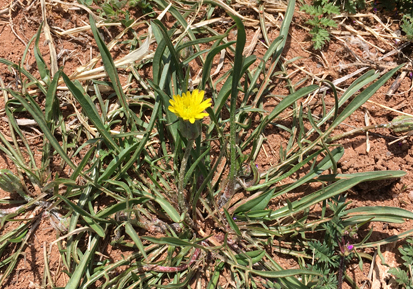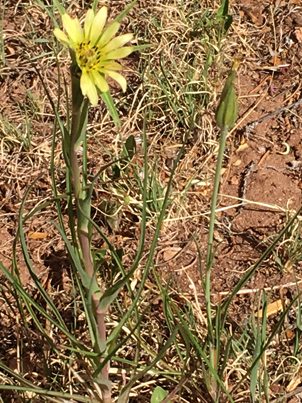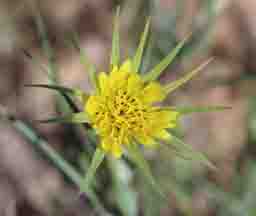
Location
Throughout the trail
Flowers first observed: 4/3/17
The Plant w/Flower
 |
 |
The Flower

Distribution
"(It) is a species of salsify native to southern and central Europe and western Asia and found as far north and west as northern France. (Wikipedia)
"Found in 45 states - all but Hawaii, Mississippi, Alabama, Florida, and South Carolina." (U.S. Wildflowers)
Description
"Like most salsifies, the western salsify grows as an annual or occasionally biennial forb, reaching a height of typically 20–60 cm but sometimes almost a metre. It grows typically in warm, sheltered spots with moist soil. Its yellow flower is 4–6 cm in diameter and is likely to be seen in late spring or early summer. Buds are blue-green, tall, and tapered. The flowers open early in the morning and often close up by late afternoon. Later the plant forms a seed head that resembles that of the dandelions but is distinctly larger. The seeds themselves (known as achenes) are 2–4 cm long but featherweight, weighing about 8 mg each on average. There is some natural variation between the central and peripheral achenes in the seedhead, with the peripheral ones being generally darker and heavier, and having a higher concentration of phenolic compounds; this may enhance their survival potential." (Wikipedia)
Ethnobotanical Uses
Food:
"Cherokee Unspecified Young plants boiled, fried, and eaten. Thompson Candy Milky latex chewed for pleasure and later swallowed. The stems were broken, the sap squeezed out, allowed to harden, and then chewed for pleasure. Thompson, Upper (Jicola Band) Unspecified Milky juice obtained from broken stem bases, dried, and chewed with great enjoyment." (Moerman 565)
"The tap root is edible and is said by some to taste like parsley while others think it tastes like oysters." (Pierce and Pierce 99)
"The thick, fleshy roots of all 3 species, collected before the flower stalks appear, can be eater raw, roasted, fried or boiled, but those of the cultivated species (common salsfy) are the largest and tastiest. They are said to taste like parsmips. Salsify roots have also been dried ground and added to cakes or roasted until they are dark brown, ground and used as a coffee substitute. Tender young leaves, buds and flowers have been added to salads or served as a cooked vegetable. The young stalks and root crowns can be gently simmered, like asparagus (Asparagus officinalis) and artichokes (Cynara scolymus), respectively. The seeds can be used to make tasty sprouts. (Kershaw 164)
"Harvest first-year roots, or second-year before the flower stalk appears (it is difficult to identify at these times; ex. an immature look-alike is Death Camas - Zigadenus spp.); otherwise, the root is too tough and bitter. The root tastes somewhat like oysters when cooked, especially the purple flowered variety. It is best in a white sauce over pasta. Also good in stew, chowder, and gumbo." (Seebeck 77)
Recipe 1: Trifecta Salsify Sampler
"A real dinner party crowd pleaser. Perfect in spring or early summer.
Harvest flower buds before they have opened. Also harvest leaves and stalks. Rinse all thoroughly in water, and gently pat dry.
Separate buds from stalks. Remove leaves from stalks and make three piles: buds, leaves, and stalks. Gently steam stalks, and place on plate, saute leaves for just a few minutes in olive oil. Sprinkle salt on top. Place on plate with stalks. Garnish with raw or steamed flower buds. Serve hot or at room temperature.
Variation: Drizzle truffle oil or hollandaise sauce over final product.
Recipe 2: Salsify Leaves Pasta Primavera
"Substitute salsify leaves for the pasta in your favorite recipe.
Harvest 4 cups leaves; wash and set aside. Prepare the following vegetables buy chopping into bite-size pieces: 1 zucchini, 1 yellow summer squash, 1 cup cherry tomatoes . Toss with enough olive oil to lightly coat the veggies; add 1 teaspoon salt. Toast in oven ant 375 degrees F until veggies are soft, about 45 minutes.
Meanwhile bring a pot of water to a boil. Boil salsify leaves for 5 minutes; drain.
To serve, line plates or serving bowl withy the boiled leaves. Top with roasted vegetables. Sprinkle with a handful of pine nuts and plenty of fresh ground black pepper. Add Parmesan cheese if desired.
Variation: For a raw pasta salad, simply use all the listed ingredients, but do not cook. Toss well with an olive oil, vinegar, and tahini dressing. Allow to sit in dressing for 10-30 minutes before serving. (Morgan 61-2)
Medicine:
"An extract of the root has been used as a remedy for indigestion." (Pierce and Pierce 99)
"These plants were used for many years to relieve heartburn and to stimulate urination (especially in the treatment of kidney stones). The milky juice was taken to cure indigestion and was applied to dressings to stop oozing and bleeding of sores and wounds. Common salsify tea was used as a drink or lotion to treat the bites of mad coyotes on both humans and livestock." (Kershaw 164)
Other Uses:
"Thompson Mats, Rugs,& Bedding Fluffy pappus of fruits used to make 'cotton' for stuffing pillows." (Moerman 565)
"Some tribes gathered the rubbery sap from broken stems and leaves, dried it and rolled it into balls. It was chewed like gum." (Kershaw 164)
Internet Links